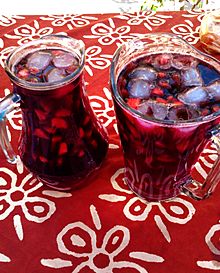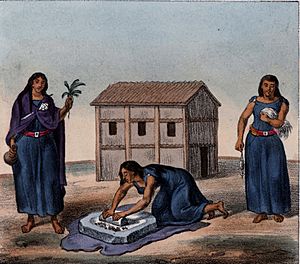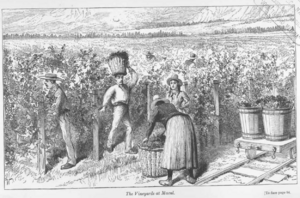Borgoña (drink) facts for kids
| Cocktail | |
|---|---|

A pitcher of Borgoña.
|
|
| Type | Mixed drink |
| Served | in a pitcher |
| Commonly used ingredients | red wine, chopped strawberries, sugar |
Borgoña is a traditional Chilean drink. It is made with red wine, chopped strawberries, and sugar. People in Chile often enjoy Borgoña during their spring celebrations called Fiestas Patrias. It is also popular in summer and around Christmas time.
In 2011, a Chilean expert looked at the calories in different traditional Chilean alcoholic drinks. Borgoña had about 250 calories per glass. This made it the fifth highest in calories among the drinks studied.
Contents
How Borgoña Came to Be
Strawberries and the Mapuche People
The idea of using Chilean strawberries to make fermented drinks started with the Mapuche people. This was written down by early historians, called cronistas, who came with the Spanish explorers.
One historian, Jerónimo de Vivar, wrote in 1558 that the Mapuche made a tasty drink from strawberries. He said it tasted like figs. In the 1600s, another writer, Diego de Ocaña, also mentioned that the Mapuche grew many strawberries. They used them to make a drink called chicha, which helped them stay strong.
Francisco Núñez de Pineda y Bascuñán, a Spanish captain, wrote in 1629 about how important strawberries were to the Mapuche. He saw them eating very large strawberries and making drinks from them.
In the mid-1700s, Chilean historian Vicente Carvallo y Goyeneche described how the Mapuche prepared strawberries. He said they called the Chilean strawberry Quellghen. They would dry the strawberries and soak them in water during winter or spring. This would make a fragrant, good-tasting cider.
Even in the 1900s, the Mapuche continued to use strawberries in their drinks. They sometimes added them to apple chicha along with other fruits.
It is thought that using strawberries in alcoholic drinks, especially wine, likely began in areas where vineyards were already growing in the 1600s. The Society of Jesus (a religious group) helped spread vineyards in these regions.
The Name "Borgoña" Arrives
In the mid-1800s, there was a trend in Europe to value French wines very highly. People started to make wines that tried to copy French ones. These wines were often called names like "Burdeos" (Bordeaux), "Borgoña" (Burgundy), and "Champagne."
At the same time, local Chilean grape types were not as valued. Soon, the name Borgoña became widely used by winemakers and farmers. It was used to describe certain types of French wines.
In 1841, a French scientist named Claudio Gay visited a Chilean vineyard. He saw many French grape varieties growing there, like Cabernet Sauvignon and Pinot from Burgundy.
Gay also noticed that in the city of Valparaíso, some sellers would mix different local wines. They added alcohol, sugar, and other things to make them taste like foreign wines. This way, they could sell them as "Port," "Malaga," or "Madeira."
By the mid-1800s, wine advertisements were not very clear about the grape type. At first, a wine might be called "Bordeaux-style." But later, it would simply be labeled "Bordeaux" or "Burgundy." This is how the word Borgoña became popular to describe types of French wines.
See also
 In Spanish: Borgoña (bebida) para niños
In Spanish: Borgoña (bebida) para niños



